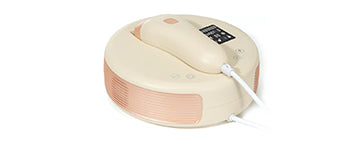What is the IPL?
Intense Pulsed Light, or IPL for short, is a flexible and non-invasive cosmetic process that uses high-intensity light with a broad spectrum to treat various skin and hair conditions. IPL is also commonly referred to as a laser treatment. Because of its efficacy in removing hair, rejuvenating the skin, and treating a variety of skin disorders, it has garnered a significant amount of public attention in recent years. IPL works by targeting and heating only specific wavelengths of light, which doesn't hurt nearby tissues. This process heats the melanin in the hair or the pigmentation in the skin without scarring them.
Intense Pulsed Light (IPL) is a versatile cosmetic procedure with several applications. Let's explore the key benefits of IPL:
- Hair removal: IPL is highly effective in eliminating unwanted hair from various body areas. People with fair skin and dark hair tend to see the best results, but technological advancements have expanded their applicability to a broader range of skin and hair types. During an IPL hair removal session, a handheld device emits a strong pulse of light that melanin in the hair absorbs. This light energy is transformed into heat, targeting the hair follicles and preventing new hair growth. Over a series of treatments, the treated hair becomes finer and less visible, providing long-lasting results.
- Skin rejuvenation: IPL is an excellent therapy for various skin issues, including sun damage, age spots, freckles, redness, and visible blood vessels. It improves skin texture and appearance. IPL devices utilize light energy to target blood vessels and pigmented cells, activating the body's natural healing response, which leads to reduced redness and the elimination of pigmentation issues. Skin rejuvenation with IPL is commonly performed on the face, neck, chest, and hands, resulting in a more youthful complexion.
- Acne treatment: IPL has shown potential as an acne treatment by targeting the bacteria responsible for outbreaks and reducing inflammation. IPL light targets problematic areas of the skin where acne bacteria absorb it. This absorption generates free radicals within the bacteria, causing damage and leading to a reduction in acne lesions and an improvement in skin texture.
- Rosacea treatment: IPL is an effective treatment for the symptoms of rosacea, a chronic skin condition characterized by facial redness and visible blood vessels. This light therapy addresses issues like redness and the appearance of blood vessels, resulting in a more even complexion. Achieving optimal outcomes requires multiple sessions.
- Photofacials: Photofacials, also known as IPL facials, are gaining popularity for skin rejuvenation. They target a variety of skin imperfections, including age spots, sun spots, fine wrinkles, and overall skin tone. During the procedure, the IPL device is passed over the patient's skin multiple times to address different issues. People commonly use photo facials for general skin rejuvenation and anti-aging.
- Minimal downtime: One of the significant advantages of IPL treatments is the minimal recovery time. Most patients can quickly return to their regular activities after an IPL session. The main side effects are mild redness and occasional slight swelling. After IPL treatment, it's essential to use sun protection and minimize sun exposure to prevent potential pigmentation changes.
- Multiple sessions: IPL treatments often require multiple sessions for optimal and long-lasting results. While some improvement may be visible after the first session, most patients need several sessions to achieve the full extent of their desired outcomes. The exact number of sessions varies based on a person's skin type and the severity of the condition.
In summary, IPL is a versatile and proven method for addressing various skin and hair conditions. Whether you seek hair removal, skin rejuvenation, acne treatment, or relief from rosacea symptoms, IPL can provide lasting results. For maximum IPL benefits, consulting with a qualified and experienced practitioner who can customize the treatment to your unique needs, ensuring the best possible outcomes, is crucial.
How does IPL hair removal work?
Removing unwanted hair with IPL (intense pulsed light) involves inflicting damage to the hair follicles by putting high-intensity bursts of broad-spectrum light onto them, which causes the hair follicles to become permanently damaged. The first step is to direct the light toward melanin, a pigment found in hair. Taking this step is the first requirement. Melanin is the pigment that is accountable for the transformation of light's energy into heat on the surface of the skin. This heat will eventually reach the hair follicle, and once there, it will inhibit the hair follicle's ability to produce new hair, resulting in the loss of existing hair. IPL works best on those who have a contrast between light skin and dark hair, as this helps with optimal follicle targeting, which is because pale skin is easier to see than dark hair. Those with dark hair and light skin are said to be great candidates. It is often necessary to arrange multiple treatment sessions to catch the strands in their best growth phase, which must be challenging. However, after a given period has passed, most people will notice a considerable and permanent decrease in the amount of hair on their body, with the regrowth appearing thinner and less apparent than it did previously. This phenomenon is known as telogen effluvium. It is of the utmost importance to adhere to all safety procedures, such as using eye protection and avoiding exposure to the sun, to reduce the likelihood of experiencing any negative consequences. Following all necessary safety procedures can accomplish this.
What are the side effects of IPL?
IPL, or intense pulsed light, is a commonly used method for hair removal and skin rejuvenation. However, like any medical or cosmetic procedure, it carries some risk of side effects. Before opting for an IPL treatment, it's essential to understand these potential adverse effects, which can vary from person to person depending on factors such as skin type, hair color, and the technician's expertise.
Here are the typical adverse effects associated with IPL treatments:
Redness and swelling: After an IPL treatment, the treated area may experience temporary redness and swelling akin to a mild sunburn. These effects usually last a few hours to a couple of days. Applying a cold compress or aloe vera gel can alleviate these symptoms.
Pigment changes: In some cases, IPL can lead to changes in skin pigmentation, causing either darkening (hyperpigmentation) or lightening (hypopigmentation), which is more likely to occur in individuals with darker skin tones. While these changes are typically temporary, sun exposure without proper protection can make them more noticeable.
Blisters: Although uncommon, blistering can be a side effect of IPL treatment. It often results from incorrect settings, insufficiently experienced personnel, or failure to follow pre- and post-treatment care instructions. You must inform your treatment provider if you experience blisters and treat them carefully to avoid infection.
Pain or discomfort: Some patients may feel pain or discomfort during or after an IPL session, often described as a sensation similar to snapping or stinging in the treated area. Patients typically experience minimal and short-lived pain, which can be managed with topical anesthetics or cooling substances.
Peeling and crusting: A few days after an IPL treatment, the skin may appear crusted or scaly as part of the natural recovery process. Avoid picking or scratching the treated area to reduce the risk of complications.
Burns: Although rare, burns can occur with IPL treatments, typically due to incorrect equipment use or setting adjustments. Ensuring the practitioner's qualifications and expertise can help reduce the risk of burns, which can be painful and potentially leave scars.
Eye injuries: IPL equipment emits a bright light that can potentially cause eye injuries, as the eyes are sensitive to radiation. It's crucial to wear protective eyewear during treatment to prevent conditions such as corneal damage and vision issues.
Hair regrowth: IPL is known for slowing hair growth, but it may not result in permanent hair removal for everyone. Some individuals, especially those with hormonal imbalances, may experience hair regrowth, necessitating maintenance treatments.
Allergic reactions: While extremely rare, some individuals may be allergic to the gel or cooling agents applied during the IPL process. It's essential to discuss any known sensitivities or allergies with your care provider before starting treatment.
Reducing the likelihood of adverse effects involves selecting an experienced practitioner, following pre- and post-treatment care instructions, and using the correct settings based on your skin type and desired outcome. Consulting a licensed specialist before IPL treatment allows for a thorough evaluation of your skin and medical history to determine if IPL is suitable for your needs. Open communication with your healthcare provider and adherence to their guidance can further minimize the risk of unwanted effects.
Is permanent hair removal possible with IPL?
Even though IPL (intense pulsed light) hair reduction is a generally accepted procedure for eliminating unwanted hair, it cannot guarantee the complete and permanent elimination of hair for every individual. However, it does offer extensive and long-lasting outcomes, which is one reason why many people select it as their strategy of choice. The effectiveness of IPL varies from patient to patient and depends on a wide range of factors, including the patient's skin type, hair color, and how their bodies react to the therapy.
IPL accomplishes its goal of permanent hair reduction by selectively targeting and destroying the hair follicles that lie beneath the surface of the skin. This damage inhibits their ability to grow new hair, so you should anticipate seeing a significant drop in hair density after receiving several treatments for this condition. In addition, the hair that eventually grows back is typically thinner and less prominent. It is crucial to note that the phrase "permanent hair removal" can be somewhat misleading because, for most people, to keep unwanted hair at bay, some maintenance may be necessary. Taking this into consideration is essential.
As a consequence of this, many individuals discover that they need to undergo recurrent maintenance treatments to achieve the level of hair removal they desire. These sessions, tailored to each individual's specific requirements, help maintain the effects achieved through the initial treatments. Therefore, it is necessary to contact a certified professional or a dermatologist to talk about your specific objectives and develop a bespoke treatment strategy that caters to your needs most effectively.
IPL hair removal, in a nutshell, is an efficient method that, when repeated over time, drastically reduces the amount of undesirable hair growth. Although it cannot guarantee permanent hair removal for everyone, it can deliver lasting effects for a considerable amount of time. Individual factors such as skin type and hair color have a part in determining how effectively it works, and some people may require occasional maintenance treatments to keep the results they want. You can design a tailored treatment plan that aligns with your requirements and objectives if you seek the advice of a qualified professional.
Is it more effective to use IPL than to shave?
When it comes to getting rid of unwanted hair, you should make your decision between shaving and intense pulsed light (IPL) based on your personal preferences as well as the demands of your particular situation. Because each approach has its own set of benefits and drawbacks, the only way to determine which one is the better one for you is to evaluate your requirements and objectives and compare them side-by-side.
People seeking only a semi-permanent treatment frequently choose IPL because of its extraordinary effectiveness in slowing hair growth. IPL results in not only the elimination of hair but also a permanent reduction in the amount of hair that grows back. You will, as time passes, observe that the regrowth of hair in the treated regions is thinner. IPL is a desirable option for people who want smoother skin but don't want the burden of maintaining it regularly because of this.
Shaving, on the other hand, is a strategy for hair removal that is quick but also convenient, inexpensive, and accessible. You can efficiently perform shaving at home. It is a tried-and-true method for instant hair removal, making it an excellent choice when you require prompt outcomes. Shaving is an inexpensive option because it requires no additional equipment, and individuals can do it themselves without needing professional assistance.
Nevertheless, it is vital to keep in mind that there are significant differences between the two approaches. IPL, even though it is quite adequate, cannot be the most convenient option in terms of both time and money. IPL treatment usually requires several preliminary sessions, and in some instances, professional treatment may be necessary to achieve the desired level of effectiveness. Compared to shaving, IPL treatment significantly reduces the risk of skin irritation and ingrown hairs, although some patients may still experience discomfort during their sessions.
On the other hand, shaving is virtually painless and, in the vast majority of cases, causes only a little bit of irritation at most. Because it is adaptable and works well with a variety of different hair and skin tones, it is a popular option among a large number of people.
Your skin tone and the color of your hair both have a significant impact on how well the IPL procedure works for you. Because of the stark contrast that it creates, it works particularly effectively for those who have pale skin but dark hair, which is because the difference makes it easier to target hair follicles. However, shaving is an option that may be used for a variety of skin and hair types, making it a flexible choice.
In conclusion, your priorities and long-term goals should serve as a compass to guide your judgment when deciding whether IPL or shaving is the better method for hair removal. IPL is a great option to consider if you want to get a hair reduction that is only semi-permanent and is willing to attend many treatment sessions. Shaving is likely the method of choice if your primary goal is to remove hair as soon as possible while also minimizing your financial investment. In the end, taking into account aspects such as how convenient the method is, your willingness to spend, and the desired results can help you make an informed decision about the most effective method of hair removal tailored to your specific needs and preferences. When picking between shaving and IPL, other aspects to consider include how sensitive your skin is and how much time you are willing to spend on either method. People with certain skin disorders or who recently got a tan may not be good candidates for IPL treatment. On the other side, shaving is an option that is both fast and simple, but it may require more upkeep than other methods. Before settling on a choice, it is essential to give careful consideration to all of these aspects. It is important to note that IPL treatment can provide longer-lasting results compared to shaving, as it targets the hair follicles directly. However, it may require multiple sessions to achieve the desired results. Additionally, shaving can sometimes cause skin irritation or ingrown hairs, especially for sensitive skin. Therefore, understanding your skin's needs and considering the long-term commitment of each method will help you make an informed decision.






